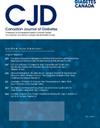Exercise Training for People With Diabetes-related Foot Ulcers: A Systematic Review of Glycemia, Fitness, and Wound-healing Outcomes
IF 2.3
4区 医学
Q3 ENDOCRINOLOGY & METABOLISM
引用次数: 0
Abstract
Objectives
Regular physical activity is a key, patient-centred therapy for people with diabetes to manage their glycemia. The International Working Group on the Diabetic Foot recommends optimization of glycemic management for people with/at risk of diabetes-related foot ulcer (DFU); however, people with DFU are commonly instructed by clinicians to avoid physical activity so as not to worsen the ulcer. The effects of exercise on glycemia, fitness, and wound healing in people with active DFU are not clear. In this study we examined the effects of regular exercise (training) on glycemia, cardiorespiratory fitness, muscular strength, metabolic health, and ulcer healing in adults with diabetes and an active foot ulcer.
Methods
Online databases and reference lists of included studies were searched from earliest records to December 2023. Studies involving adult populations with DFU and incorporating interventions of exercise training were included. Data were extracted independently by 2 reviewers.
Results
Of the 5,592 studies screened, 8 were included, with a total of 213 participants. Exercise interventions involved foot range-of-movement exercises and/or aerobic and/or resistance-type exercise. None of the studies reported on cardiorespiratory fitness or anthropometry and limited data were available for glycemic and muscular strength outcomes. Interpretation of data on safety, wound healing, and adherence to exercise were limited due to inconsistent reporting.
Conclusions
Despite some data that exercise may have a positive impact on wound healing, evidence regarding its benefits and safety is significantly lacking, despite metabolic (particularly glycemic) and fitness outcomes being core to the rationale for exercise therapy in diabetes. Given the importance of exercise in current management guidelines for diabetes, and the plausibility of positive health effects of exercise training for people with DFU, there is a need for research to move from foot-focussed to person-centred outcomes to better inform the implementation of exercise therapy for people with DFU.
糖尿病相关足溃疡患者的运动训练——对血糖、健康和伤口愈合结果的系统回顾
背景:规律的身体活动是糖尿病患者控制血糖的关键、以患者为中心的治疗方法。糖尿病足国际工作组(IWGDF)建议糖尿病相关性足溃疡(DFU)风险人群优化血糖控制,但DFU患者通常被临床医生指示避免身体活动,以免溃疡恶化。运动对活动性DFU患者血糖、体能和伤口愈合的影响尚不清楚。目的:研究定期运动(训练)对糖尿病和活动性足溃疡成人患者血糖、心肺健康、肌肉力量、代谢健康和溃疡愈合的影响。方法:检索最早记录至2023年12月的在线数据库和纳入研究的参考文献。纳入了涉及患有DFU的成年人群并结合运动训练干预的研究。数据由两位审稿人独立提取。结果:在筛选的5592项研究中,有8项研究共纳入213名参与者。运动干预包括足部活动范围运动和/或有氧和/或阻力型运动。没有关于心肺健康或人体测量的研究报道,血糖和肌肉力量结果的数据有限。由于报道不一致,对安全性、伤口愈合和坚持锻炼数据的解释受到限制。结论:尽管一些数据表明运动可能对伤口愈合有积极影响,但关于其益处和安全性的证据明显缺乏,尽管代谢(特别是血糖)和健康结果是糖尿病运动治疗的核心原理。鉴于运动在当前糖尿病管理指南中的重要性,以及运动训练对DFU患者的积极健康影响的合理性,有必要将研究从以足部为中心转向以人为中心的结果,以更好地为DFU患者的运动治疗实施提供信息。
本文章由计算机程序翻译,如有差异,请以英文原文为准。
求助全文
约1分钟内获得全文
求助全文
来源期刊

Canadian Journal of Diabetes
ENDOCRINOLOGY & METABOLISM-
CiteScore
4.80
自引率
4.00%
发文量
130
审稿时长
54 days
期刊介绍:
The Canadian Journal of Diabetes is Canada''s only diabetes-oriented, peer-reviewed, interdisciplinary journal for diabetes health-care professionals.
Published bimonthly, the Canadian Journal of Diabetes contains original articles; reviews; case reports; shorter articles such as Perspectives in Practice, Practical Diabetes and Innovations in Diabetes Care; Diabetes Dilemmas and Letters to the Editor.
 求助内容:
求助内容: 应助结果提醒方式:
应助结果提醒方式:


